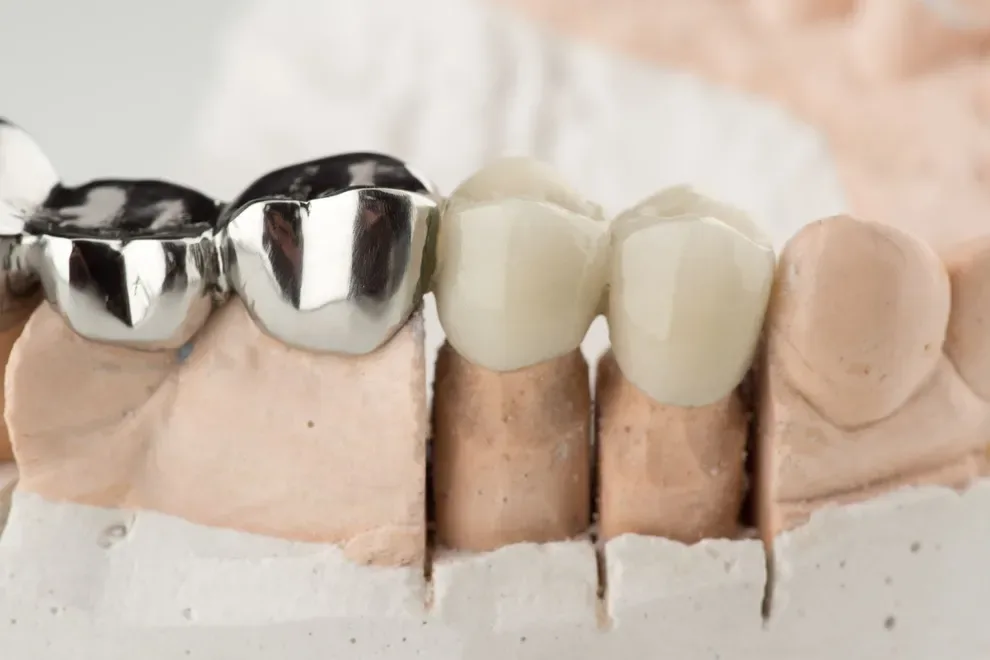Stainless Steel Crowns: Are They Safe for Children?

Table of Contents
- Stainless Steel Crown
- Stainless Steel Crown for Children
- Safety & Longevity
- Associated Costs
- References
Stainless steel crowns (SSCs) are some of the most frequently used crowns for children, as they can offer durability, strength, and protection for a baby tooth.
It is important to try and save a child’s baby tooth if possible. This can often be accomplished by placing one of these “silver hats” or “caps” on top of the tooth to preserve it until it falls out naturally — to be replaced by a healthy adult tooth.
Stainless steel crowns can cover more than a traditional filling can. They are a safe and effective method to restore and reshape a primary tooth that has been impacted by extensive decay or breakage.
What Is a Stainless Steel Crown?
A stainless steel crown is a tooth cap that fits over the top of a child’s primary tooth to help strengthen, reshape, and provide structure in order to preserve the tooth. Dental crowns are designed to restore a damaged tooth.
In children, baby teeth are necessary to help the mouth form correctly. It is important to keep the primary teeth in place until the permanent teeth come in and push them out. Stainless steel crowns can be used to maintain this spacing by helping the baby tooth to last longer.
SSCs can be placed in one visit, as they are preformed and come in different sizes to be fit and molded to the child’s tooth. They can help a child to eat, talk, and smile more comfortably.
When a Child Needs a Stainless Steel Crown
Tooth decay, caused by plaque and tartar buildup on a tooth, can become significant and cause much of a primary tooth to be damaged. When this decay is excessive and cannot be covered by a traditional cavity filling, a dental crown is often needed. Stainless steel crowns are the most common type of crown used for children.
Birth defects and trauma to a tooth can cause it to become severely damaged, broken, or chipped. This may require a stainless steel crown to restore and preserve the tooth until it falls out to be replaced by a permanent tooth.
In 1950, Dr. Humphrey was the first to introduce stainless steel crowns to pediatric dentistry, also referred to as preformed metal crowns.
Safety & Longevity of Stainless Steel Crowns
Stainless steel crowns are highly effective in maintaining primary teeth and can last as long as the tooth does. They are considered safe, efficient, and cost-effective.
Typically, a SSC will last about four years or so. Often, the primary tooth will fall out on its own before the stainless steel crown will actually fail.
Considered to be the most successful for restoring primary molars that have multiple cavities, stainless steel crowns are impressively successful. Stainless steel crowns work well to hold the place for secondary teeth and maintain their function.
One of the biggest issues with stainless steel crowns is their silver appearance and therefore a child’s satisfaction with their smile. Stainless steel crowns are often best for molars and back teeth for this reason.
Associated Costs
Stainless steel crowns are considered to be more cost-effective than the more aesthetically pleasing tooth-colored crowns that take more time for a dentist to place. On average, a stainless steel crown will cost between $400 and $1,000.
The following factors can influence the cost:
Type of material used for the crown
Where the crown is being placed and how difficult the procedure is
Whether or not additional procedures are needed and necessary prep time
Location and experience of the dentist
Use of insurance or a dental discount plan
Stainless steel crowns can help a child to eat and talk more normally. They are exceptionally durable, hold up well, and can aid in stopping the spread of tooth decay and further damage to a tooth.
